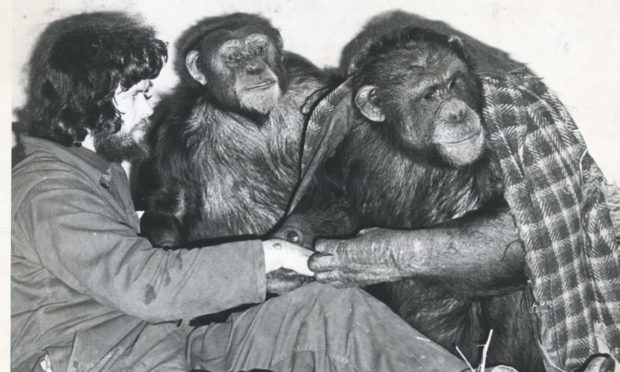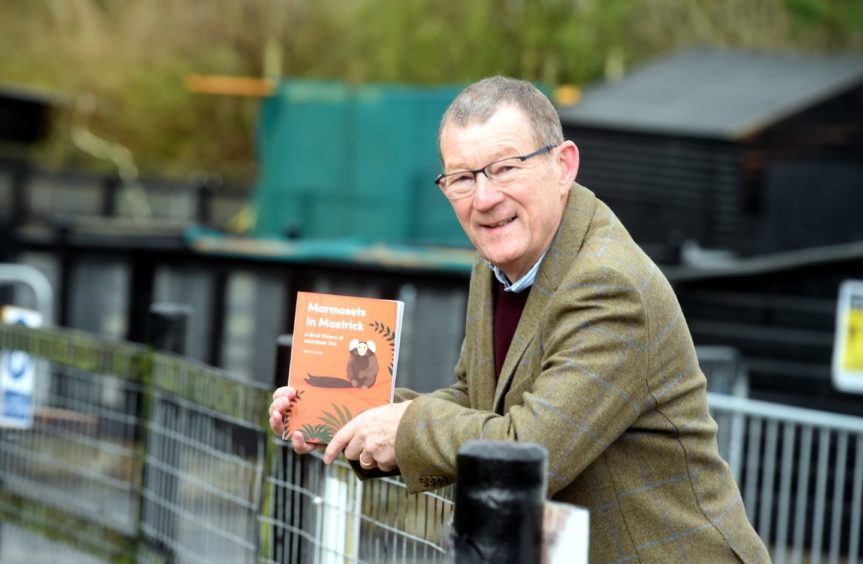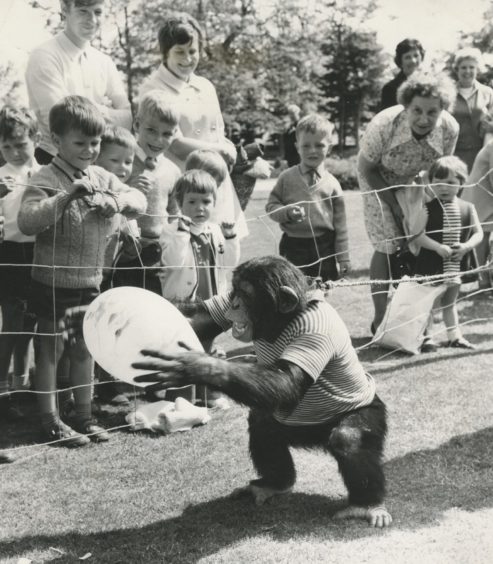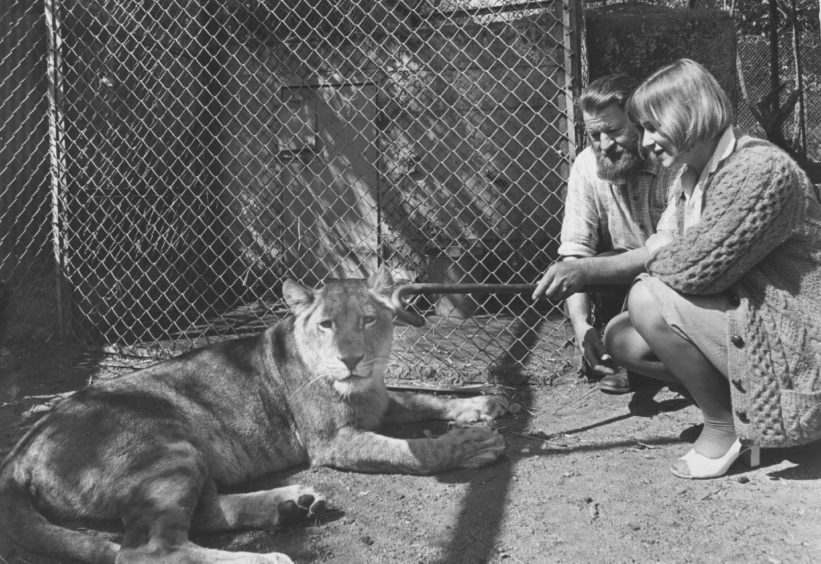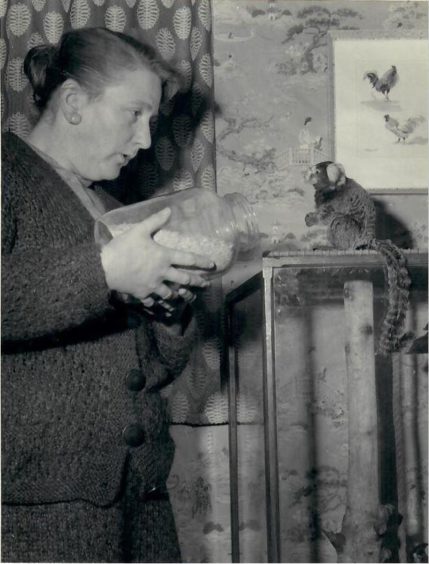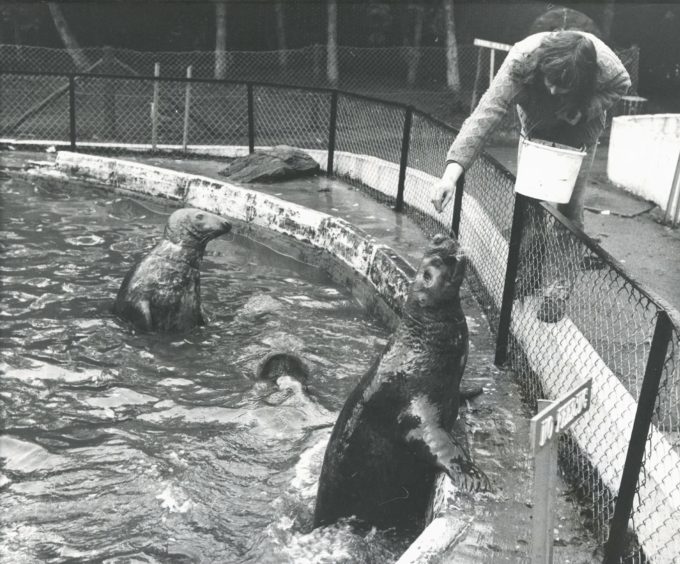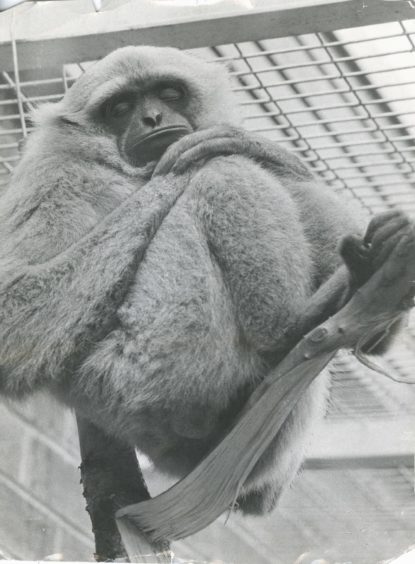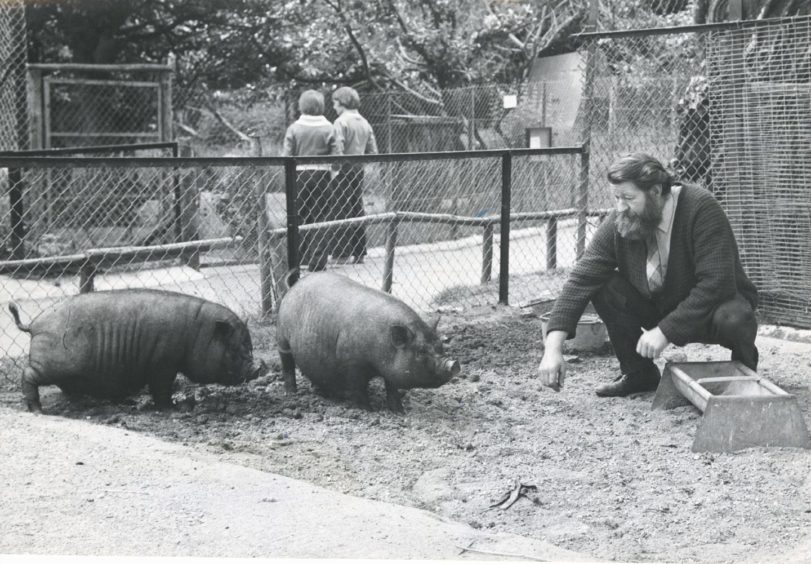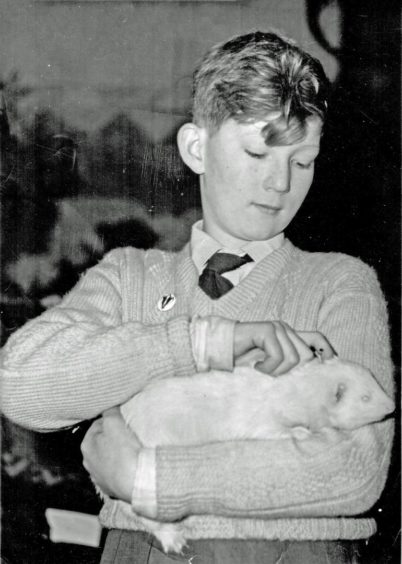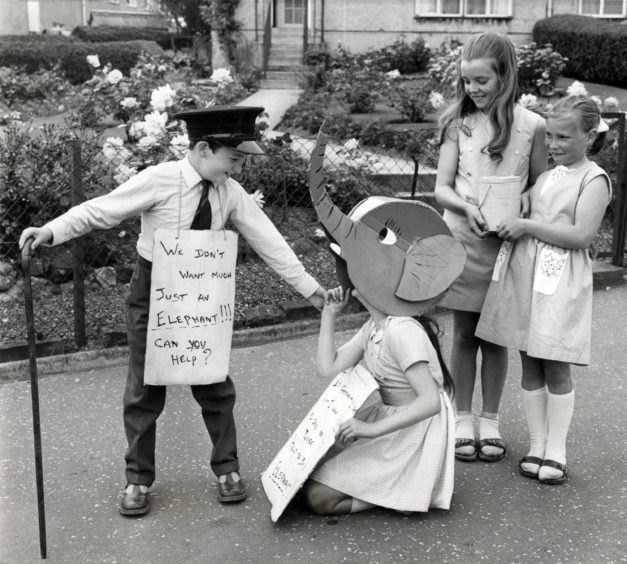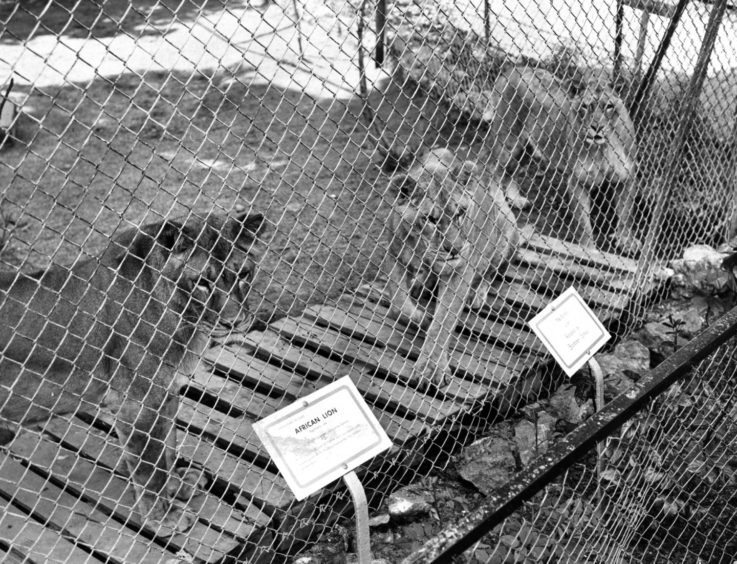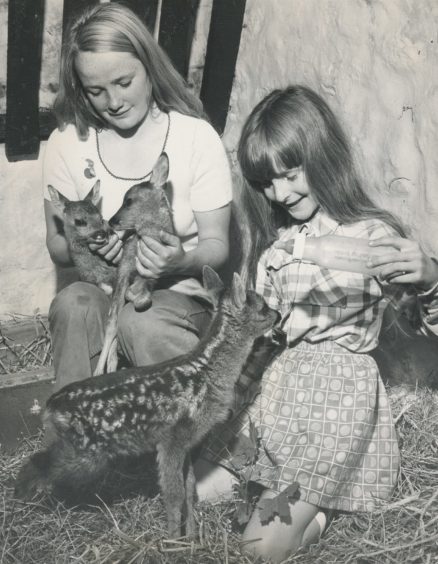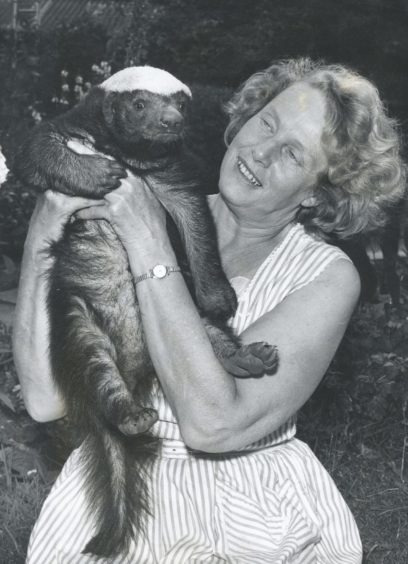It’s not every day you come home and find a chimpanzee sitting in your armchair eating cake and chocolate biscuits after ransacking your larder… but then it’s not everyone who grew up with Aberdeen Zoo in their backyard.
The story of Humphrey, the greedy chimp, is just one of many exceptional memories Robert Leslie has of his teenage years when his father, George, was manager of the zoo at Hazlehead Park in the 60s and 70s.
Now Rob has penned a new book, Marmosets In Mastrick: A Brief History of Aberdeen Zoo, which gives a fascinating insight into this now almost forgotten attraction – along with vivid stories including marmosets traded for cigarettes, a close encounter with a snarling puma and a couple of prickly escape artist porcupines.
And then, there was Humphrey the chimp who initially lived with the family in the manager’s house at the zoo itself, which held a range of creatures from lions to bears, wolves to chimps, and otters to seals.
Chimp was so cheeky
“Humphrey was just a character,” said Rob. “He was given baby clothes because when he was brought into the country, he was suffering from the cold and he was in nappies because he was in the house.
“He was so cheeky, he was just like a kid. There was the day we came back and Humphrey had managed to get himself out of his cage. He had ransacked the larder to find fairy cake, and I do mean ransacked. Everything was everywhere. He was sitting on one of the easy chairs with a lump of cake in one hand and a chocolate biscuit in the other.”
The origins of the zoo started long before its official opening in July 1966. It was the brainchild of Dr Lil de Kock, of the University of Aberdeen’s zoology department, who was joined by like-minded individuals in driving the idea forward at the start of the 60s.
That included Rob’s father, George, then a porter at Aberdeen Royal Infirmary, but who also had a keen love of the natural world and became a key player in the Aberdeen and North of Scotland Zoological Society.
As the physical zoo was being built at Hazlehead Park, where Pet’s Corner is today, animals for the collection were being gathered and donated and housed at various places and homes across the city, with George organising the farming out of the beasts, from donkeys to monkeys.
Which is how there came to be marmosets in Mastrick.
Bartered for cigarettes
Rob said: “We had an aviary stuck at the back of our council house at Sheddocksley Road, so we had various birds, cats and the marmosets… a whole pile of things.
“Marmosets make a very high-pitched noise and the marmoset we had, a male named Sinni, kept looking out the window at more or less the same time every morning, making this noise. We discovered by chance a family nearby had another marmoset, a female named Chico. She had been bartered for a packet of cigarettes in Rio de Janeiro and brought back to the UK. There wasn’t a lot of regulation back then.
“At the same time Sinni was whistling and looking to the south, the female was looking towards our house and whistling.”
When the neighbours heard of the plans for the zoo, they donated their marmoset. Chico and Sinni went on to breed successfully, producing twins every year from 1963 to 1967.
Once the Leslies moved into the manager’s house at the zoo, Rob found himself deeply involved in the world of the zoo and its animals.
“I was there while the zoo was being built, then I was working there during the school holidays, helping out,” said Rob. “But it is all consuming. You can imagine that because one of the walls of the house forms the perimeter of the zoo, it is a 24/7, 365 days a year calling, if you like.
“I remember my father and mother were away at one time and some cables came down in a bit of a storm. I had to climb trees and throw cables from one building to another to get heaters going to make sure the animals didn’t perish. But it was interesting, I have to say,” said Rob, who actually went on to follow a successful career in construction, including lecturing at Robert Gordon University.
Virtually everything bites
The zoo was clearly something Rob loved and has many fond memories of, including those of his favourite creature, Sparky the gibbon.
“He used to see me coming and swing round and get his back scratched,” said Rob. “But your ambition at the end of the day was still to be able to count to 10 on all your fingers. Virtually everything bites and it’s a case of just being aware of that.”
Rob said that message was constantly drilled into the many volunteers who came along to work at the zoo. One young volunteer had a sharp lesson on the need to take care around the beasts they were tending. For reasons best known to himself, the lad had gone into the mountain lion enclosure and ended up confronted by a puma.
“There was a tree in the enclosure… and this young lad was trying to climb that tree with the aid of his shoulder blades because he was just pinned to it, with this thing spitting in front of him,” said Rob.
“That was very serious but he was rescued and no one was hurt. But I’m sure it’s an event he will never forget.”
Of course, not all the close encounters with the animals was in an enclosure. Some of them were very adept at making a great escape. Especially the porcupines.
‘Duel’ over differences
“Mostly it was rabbits and sheep and things like that which found their way into Hazlehead Park, but the main ones were the two porcupines. They got out at regular intervals. They just shimmied up the tree that was there and waddled along the branch and dropped down the other side,” said Rob, adding they could get quite far.
“By chance, Lil de Kock was travelling on a backroad between the zoo and Cults one evening and saw a porcupine that got out of the zoo and this was quite a bit away. She managed to recapture it. But one did eventually disappear, never to be seen again.”
One of Rob’s most memorable stories revolves around Gavin Maxwell of Ring Of Bright Water fame who was at the zoo to discuss with his father, George, housing one of the otters featured in the acclaimed book.
“They had consumed quite a bit of alcohol at the weekend and things got ‘interesting’, shall we say,” said Rob, describing Maxwell’s demands on the zoo as “exacting”.
By interesting, Rob means his father and Maxwell decided after drinking into the early hours the only way to settle their differences was to have a duel. Maxwell was going to get a revolver from his car, while George was going to get his shotgun.
Rob’s mother woke him up and after some ”cajoling” the pair agreed to sleep it off instead. The deal fizzled out thereafter.
People surprised by zoo
When the zoo first opened, there were ambitious plans to expand it, taking in almost 10 acres of Hazlehead Park and bringing in more and more animals. There was even a campaign to bring an elephant to the zoo, with members of the public donating to the fund in a period of “jumbo” frenzy in the Granite City.
But the idea was scrapped, along with any hopes of expansion, as council support for the zoo dwindled, along with funds from the city coffers.
Eventually, facing financial difficulties, the zoo closed in 1977, despite a huge public outcry and pleas to save it.
Now Rob has written Marmosets In Mastrick to pay tribute to the place, its animals and exceptional staff, such as head keeper John Buchan, who made the zoo such a memorable institution.
“I think a lot of younger people are surprised that there was a zoo and that it had lions and chimpanzees,” he said, adding the older generation still have fond memories of it.
“I went up to the Pet’s Corner and was talking to the guy who has been there 20 years. He still has people coming in and saying: ‘I gave money to the elephant fund all those years ago, but you don’t have an elephant, so can I have my money back?'”
Rob has included chapters about the zoo’s animals written by his father before his death, as well as drawing on a treasure trove of George’s extensive record of minutes from meetings of the zoo society as well as press cuttings.
In his book, Rob is unflinching about his father’s problem drinking, wanting to be open about it rather than have it viewed as a “serious omission” by people who knew George.
But despite his drinking George was always devoted to the animals in his care and to making the zoo a success – something which Rob emphatically says it was.
Zoo was a success
“The amount of people who came to the zoo was phenomenal,” said Rob. “But also the breeding success the zoo had. Despite my father having effectively fallen out with Gavin Maxwell, a few years later he was awarded the Gavin Maxwell Award because Malayan otters bred at Aberdeen Zoo for the first time outside Malaysia.”
Rob also praised the zoo’s exemplary and ground-breaking education work. Every month when they had children coming along to a zoo club, there was an average attendance of 200 to 250 children.
Marmosets in Mastrick was published last month and Rob hopes it will raise more awareness of Aberdeen Zoo, its compelling stories and the success it enjoyed.
“In the north-east, we hide our light under a bushel. Sometimes, I don’t think we tell people that we were successful. The zoo, by numbers, by breeding, by education, it was a success.
“There was a lot going for it and I just wanted to record that there was such a thing. It’s a bit of Aberdeen’s history.”
For more information on Marmosets In Mastrick, visit the Aberdeen Zoo Facebook page.
